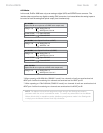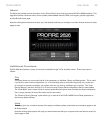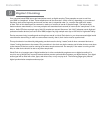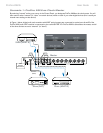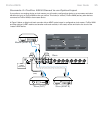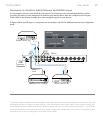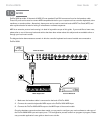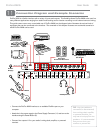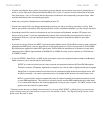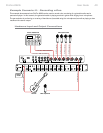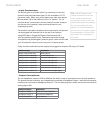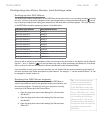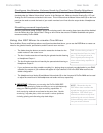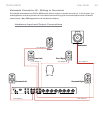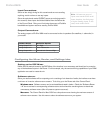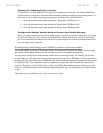User Guide 39ProFire 2626
• Ifyouarerecordingthedirectoutputofanyelectricguitarsorbasses,connecttheseinstrumentstoAnalogInputs1
and 2 (1) on the front panel. Be sure the Mic/Inst Button (2) is in the “in” position for each channel that is using the
front panel inputs. If any 1/4” line-level devices have been connected to the corresponding rear-panel inputs, make
sure that these devices are not outputting any audio.
• AttachuptotwopairsofheadphonestotheHeadphonejacks(7).
• Connectlineoutputs3-8toanydeviceswithanaloginputsthatyouwishtouseduringrecordingormixing.Such
devices can include compressors, EQs, signal processors, mixers, or additional speakers if you are mixing in surround.
• Useanaloginputs3-8toconnectmicrophonesoranyline-leveldevices(keyboards,samplers,CDplayers,etc.)
that you wish to record. If you have attached analog outputs 3-8 to external audio processing devices (such as
compressors, EQs, etc.), you can use these inputs to bring the outputs of those devices back into your audio
application.
• IfyouwishtouseanydeviceswithADAT*inputsandoutputs(digitalmixers,A/DandD/Aconverters,othercomputers
equipped with ADAT ports), connect these devices to the optical connectors (13) on the rear panel of ProFire 2626.
By combining the signals from both ADAT optical ports, ProFire 2626 can send/receive 16 channels of audio while
operating at 44.1/48 kHz, eight channels at 88.2/96 kHz (in S/MUX II mode), and four channels at 176.2/192 kHz
(in S/MUX IV mode).
• TousetheS/PDIF*,WordClock*,orMIDI,inputsandoutputs,connectthesuppliedbreakoutcabletotheBreakout
Cable connector (14) on the rear panel of the interface.
S/PDIF is a common format found on many consumer and professional devices (A/D and D/A Microphone
Preamps converters, CD players, keyboards and samplers, etc.) that is used to digitally transfer stereo signals.
Word Clock is a synchronization format often found on professional digital audio devices (digital mixers, A/D
and D/A converters). It is used to synchronize two or more digital audio devices to the same master clock.
MIDI is a communication protocol supported by nearly all modern keyboard and synthesizer products as well
as most DAW applications. This protocol is commonly used to connect MIDI-capable devices to each other,
or to connect these devices to the recording application running on your computer. The “MIDI” section of this
guide covers this protocol in greater detail.
* Whenever audio devices are digitally interconnected (i.e., through ADAT, S/PDIF, or Word Clock), you must set up
proper clocking among all of the devices to ensure error free transfer of audio. The “Digital Clocking” section of this
guide covers this topic in detail.



